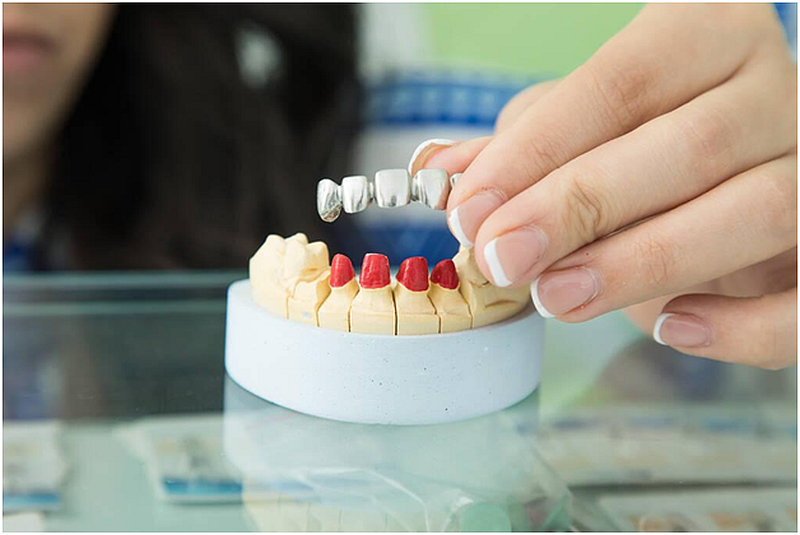Dental crowns, or dental caps, are tooth-shaped coverings placed over damaged or discoloured teeth to improve their appearance and functionality. Their primary purpose is to ensure long-lasting oral health by restoring the strength and shape of damaged teeth.
Definition and purpose of dental bridges
Dental bridges are fixed dental restorations used to replace missing teeth by joining an artificial tooth to adjacent teeth or dental implants. Their purpose is to restore aesthetics, speaking and chewing capability, and prevent other teeth from shifting.
Importance of Dental Crowns and Bridges for Oral Health
1. Replacing missing teeth
Replacing missing teeth is vital for oral health and overall well-being. Options include dental implants, bridges, and dentures. Each dental crowns and bridges offers benefits, such as improving speech, diet, and self-confidence while preventing bone loss.
2. Preventing teeth shift
Preventing teeth shift is essential for maintaining a healthy and aligned smile. Consistent use of retainers, regular dental check-ups, and proper oral care can inhibit unwanted movements in tooth positioning, ensuring a confidently beautiful smile.
3. Maximizing oral functionality
Maximizing oral functionality entails prioritizing a holistic approach to oral health. It includes daily brushing, flossing, and regular dental check-ups, but also maintaining a balanced diet and avoiding harmful habits like smoking.
Different Types of Dental Crowns
1. Ceramic crowns
Ceramic crowns are a type of dental restoration used to protect damaged teeth. They mimic natural tooth colour and translucency, providing an aesthetic solution. They are durable, biocompatible, and resist staining, ensuring a long-lasting, attractive result.
2. Porcelain-fused-to-metal crowns
Porcelain-fused-to-metal crowns are a popular type of dental restoration. They provide strength from the metal structure, while the porcelain gives the appearance of natural teeth, making them an attractive, durable option.
3. Gold alloy crowns
Gold alloy crowns are a dental restoration method widely praised for their durability, longevity, and biocompatibility. They resist wear and tear, effectively mimic natural teeth functions, and rarely cause allergic reactions, providing considerable benefits to oral health.
4. Base metal alloy crowns
Base metal alloy crowns are an affordable dental restoration option. They are made from non-noble metals, characterized by their strength and longevity. They exhibit high resistance to corrosion and tarnishing, offering durability in oral environments.
Different Types of Dental Bridges
1. Traditional bridges
Traditional bridges are a testament to human innovation and engineering, often characterized by stone, brick or wooden materials. They connect communities, enable transportation, and stand as historical and cultural symbols of unity and progress.
2. Cantilever bridges
Cantilever bridges are architectural wonders, designed for spanning long distances. They feature robust arms, supported only at one end, extending horizontally. Engineers utilize them for heavy-duty applications such as railroad crossings and highway overpasses.
3. Maryland bridges
Maryland bridges are minimalist dental devices used to replace missing teeth. Invented by Dr. Stewart R. Halbauer, this framework is bonded onto existing teeth, offering a conservative, functional solution.
4. Implant-supported bridges
Implant-supported bridges are a permanent solution for replacing missing teeth. They are anchored onto dental implants surgically placed in the jawbone, providing exceptional stability, and comfort, and restoring optimal functioning of the teeth.
The Procedure for Getting Dental Crowns

1. Initial consultation
The initial consultation involves an extensive discussion with the client to understand their requirements, objectives, and expectations from a proposed service or product. It helps establish a personalized approach to meet specific needs and facilitates effective outcomes.
2. Preparation of the tooth
Preparing a tooth involves cleaning, disinfecting and shaping the tooth structure. It’s usually done before dental procedures like fillings, crowns, or root canals. Proper preparation ensures effective treatment and long-lasting results.
3. Temporary crown placement
Temporary crown placement is a dental procedure that protects a damaged tooth until a permanent crown is ready. It prevents further damage and maintains oral functionality, ensuring the patient’s comfort and aesthetics.
4. Crown creation and placement
Crown creation and placement is a meticulous dental procedure. It involves crafting a cap-like prosthesis, often from porcelain or ceramic, to encompass a damaged tooth. This preserves functionality, and appearance and protects from further damage.
The Procedure for Getting Dental Bridges
1. Initial consultation
An initial consultation is the first crucial meeting between professionals and clients. This session primarily aims to identify concerns, set objectives, and aim towards forming an effective strategy. It lays the groundwork for a successful working relationship.
2. Preparing the abutment teeth
Preparing the abutment teeth requires precise reduction and shaping of the tooth structures. This initial process ensures a proper fit for future crowns or bridges, enhancing the dental prosthetic’s longevity and overall oral health functionality.
3. Taking impressions and temporary bridge placement
Taking impressions for dental bridges is a critical procedure ensuring the optimal fit of the prosthesis. After impressions, a temporary bridge is placed, safeguarding sensitivity and functionality, while the final piece is fabricated.
4. Bridge creation and placement
Bridge creation and placement involve meticulous planning, design and construction. It requires expert knowledge in architecture, engineering, and materials. Proper placement ensures structural integrity, functionality, and safety for users.
Care and Maintenance of Dental Crowns and Bridges
1. Proper oral hygiene practices
Proper oral hygiene practices include regular brushing, flossing, and dental check-ups. Good oral care helps maintain healthy teeth and gums, preventing cavities and gum diseases, leading to improved overall health and confident smiles.
2. Regular dental check-ups
Regular dental check-ups are vital for maintaining oral health. They help in detecting dental problems early, preventing tooth decay, and gum diseases, and ensuring overall health. Remember, a healthy mouth equates to a healthy body.
3. Avoiding hard or sticky foods
Avoiding hard or sticky foods is beneficial, especially for those with dental issues. They might damage tooth enamel or lead to cavities. Additionally, hard food risks cracking teeth or injuring your gums.
The Benefits of Dental Crowns and Bridges
1. Aesthetic improvement
Aesthetic improvement involves enhancing the visual appeal of a space, object, or person. It may include design modifications, cleanliness, maintenance, or rejuvenating aspects. Such alterations impact overall attractiveness, adding value and enriching user experience.
2. Improved chewing and speaking
Improved chewing and speaking often result from good oral health. Regular dental visits can correct misalignment, decay, or damage. This contributes to clearer speech, easier eating, and enhanced overall well-being.
3. Boosted confidence and self-esteem
Boosted confidence and self-esteem significantly influence personal growth and success. It aids in overcoming fear, embracing challenges, and achieving goals. This empowerment enables better decision-making, largely benefiting interpersonal communication and relationships.
Potential Risks and Complications of Dental Crowns and Bridges
1. Tooth Sensitivity
Tooth sensitivity is a common dental issue affecting millions globally. It emerges when the enamel is worn down or gums recede, exposing the dentin, and leading to sharp pain, especially during temperature changes. Regular visits to a dentist can help in managing it.
2. Loose crown or bridge
A loose crown or bridge can be a serious dental issue, causing discomfort and risking further damage. It requires immediate attention from a dentist who can safely secure the loosened structure back in place.
3. Wear and tear
Wear and tear is the natural, inevitable degradation of assets due to regular usage, ageing, or exposure to weather elements. It signifies the loss in value, functionality, or usefulness of a property from time-related decay.
FAQ about Dental Crowns and Bridges
How long do crowns and bridges last?
Crowns and bridges can last a lifetime with proper care. However, their average lifespan is typically between ten to fifteen years. Regular dental checkups and good oral hygiene can extend longevity.
Is a bridge better than a crown?
Both bridge and crown dental restorations have their advantages, but it largely depends on individual needs. A bridge replaces missing teeth, whereas a crown restores damaged teeth. Therefore, neither is categorically better than the other; their suitability varies per case.
Is crown and bridge painful?
A crown and bridge procedure is typically not painful. The dentist will use a local anaesthetic to numb the area during the procedure. Afterwards, slight discomfort can occur but can be managed with over-the-counter painkillers.
What cost more a crown or a bridge?
A dental bridge typically costs less than a crown. The exact price varies with dental offices and geographic location. However, it’s essential to note that the patient’s individual needs might influence the costs.
Article Submitted By Community Writer




